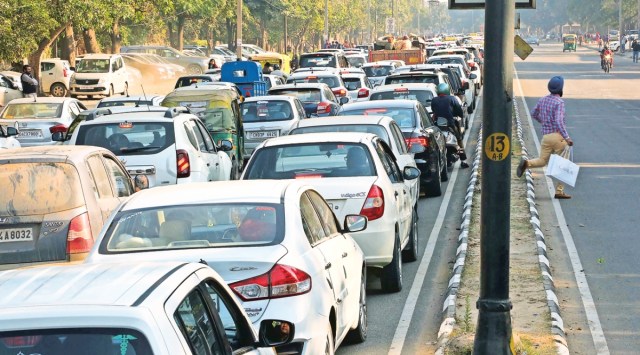- India
- International
Govt eyes tax breaks for more non-polluting tech in auto sector
Based on industry feedback, the Union Ministry of Heavy Industries is learnt to be working on a proposal regarding the broader taxation incentive structure and is likely to relay that to the Finance Ministry -- the nodal agency for deciding matters of taxation structure.
 If the plan passes muster, a formal proposal could be taken in due course before the GST Council -- the statutory body empowered to make recommendations to the Centre and states on taxation aspects under the indirect tax regime.
If the plan passes muster, a formal proposal could be taken in due course before the GST Council -- the statutory body empowered to make recommendations to the Centre and states on taxation aspects under the indirect tax regime.THE GOVERNMENT is likely to broadbase efforts to curb auto emissions by incentivising through tax concessions technologies other than just battery electric vehicles in the passenger vehicle segment, which includes conventional hybrids, fuel cells and hydrogen internal combustion engine platforms.
Initial groundwork in this direction has been initiated within the administration to pivot from the existing auto taxation structure, which offers incentivises based on the type of powertrain, to a new regime that could be platform-agnostic — and offer incentives based on yardsticks, such as lower emissions or higher mileage.
Based on industry feedback, the Union Ministry of Heavy Industries is learnt to be working on a proposal regarding the broader taxation incentive structure and is likely to relay that to the Finance Ministry — the nodal agency for deciding matters of taxation structure.
If the plan passes muster, a formal proposal could be taken in due course before the GST Council — the statutory body empowered to make recommendations to the Centre and states on taxation aspects under the indirect tax regime.
“There is clarity that the emission reduction target cannot be achieved by just (battery) electric vehicles, and other technologies also need to be incentivised. There are discussions within the Government, and the Finance Ministry is involved,” a senior Government official told The Indian Express.

Currently, there is a GST rate of 28 per cent on passenger vehicles, with the only major concession reserved for Battery Electric Vehicles (BEVs), which are taxed at 5 per cent. On top of the 28 per cent base rate, there are cesses ranging from 1 per cent to 22 per cent. Effectively, hybrid vehicles get taxed at 43 per cent, just 2 percentage points lower than the 45 per cent levied on mid-sized passenger Internal Combustion Engine (ICE) vehicles.
An earlier proposal for a lower tax on conventional hybrid vehicles led to divisions within the industry, with auto companies having no hybrid portfolio opposing the move.
Crucial juncture for sector
The Government’s move comes at a crucial juncture for the auto industry. It is rapidly upshifting from Internal Combustion Engine (ICE) system to multiple tech platforms: conventional hybrids, flex fuels, fuel cells and even hydrogen ICE, apart from battery electric vehicles.
The fresh discussions on incentives come at a time when the domestic market is seeing a renewed push for new platforms in the mass market — a slew of strong hybrid models starting with the Honda City e:HEV and subsequently, the Toyota Urban Cruiser Hyryder and the Maruti Suzuki Grand Vitara.
Both Maruti Suzuki India and Toyota Kirloskar Motor are lobbying hard for lower taxes on hybrid vehicles, citing lower emissions in city conditions as strong hybrids are claimed to run on electric power at lower speeds. Toyota Kirloskar Motor is also learnt to be readying a third hybrid model, the Toyota Innova Hycross, which is likely to be positioned as an upgrade to the Innova Crysta.
Currently, the tax incentives are focused primarily on one platform — BEVs such as Tata Nexon EV, the Hyundai Kona or Mahindra eVerito that have no IC engine or a fuel tank, and run on a fully electric drivetrain powered by rechargeable batteries.
There are three other broad EV categories:
n Plug-in hybrid vehicles, or PHEVs: They have a hybrid drivetrain and use an IC engine in combination with an electric motor for motive power backed by rechargeable batteries, which can be plugged into a power source.
n Fuel cell electric vehicles or FCEVs: With models such as Toyota’s Mirai, Honda’s Clarity and Hyundai’s Nexo, they use hydrogen gas to power an on-board electric motor. FCEVs combine hydrogen and oxygen to produce electricity, which runs the motor. Since they are powered entirely by electricity, FCEVs are considered Evs. But unlike BEVs, their range and refuelling processes are comparable to conventional cars and trucks. Fuel cell vehicles currently qualify for benefits under the Ministry of Heavy Industries’ FAME programme.
n Conventional hybrid electric vehicles or HEVs: They include the new Toyota Hyryder/ Maruti Grand Vitara models, or the Toyota Camry and Honda City e:HEV that combine a conventional internal combustion engine system with an electric propulsion system, resulting in a hybrid vehicle drivetrain that substantially lowers fuel usage. They do not have a plug-in option, unlike PHEVs. The onboard battery in a conventional hybrid is charged when the IC engine is powering the drivetrain or by regenerative braking.
Then, there are newer platforms on the anvil.
The country’s first “flex fuel” car, a Toyota sedan that can run on one or multiple fuel types, is being developed as part of a new pilot aimed at deleveraging dependence on imported fossil fuels for transportation. It is set for an unveiling later.
The pilot has been initiated as part of a Government-led push to carmakers for adopting alternative fuels. It will be part of a nationwide pilot that aims to replicate the commercial deployment of this technology in other markets such as Brazil, Canada and the US.
Apr 25: Latest News
- 01
- 02
- 03
- 04
- 05







































